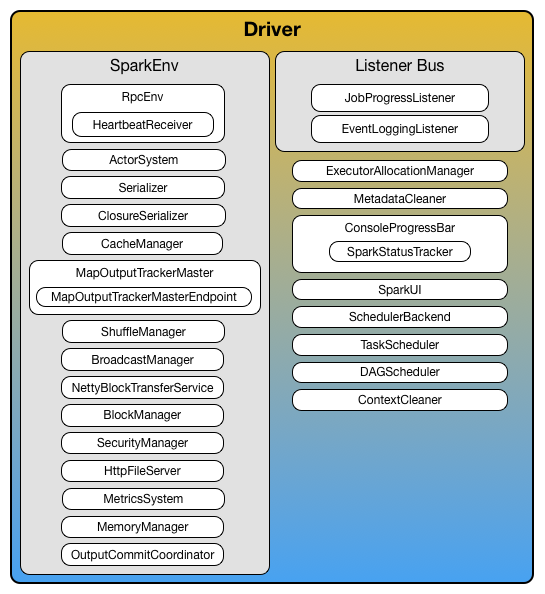
Driver
A Spark driver (aka an application’s driver process) is a JVM process that hosts SparkContext for a Spark application. It is the master node in a Spark application.
It is the cockpit of jobs and tasks execution (using DAGScheduler and Task Scheduler). It hosts Web UI for the environment.

It splits a Spark application into tasks and schedules them to run on executors.
A driver is where the task scheduler lives and spawns tasks across workers.
A driver coordinates workers and overall execution of tasks.
|
Note
|
Spark shell is a Spark application and the driver. It creates a SparkContext that is available as sc.
|
Driver requires the additional services (beside the common ones like ShuffleManager, MemoryManager, BlockTransferService, BroadcastManager, CacheManager):
-
Listener Bus
-
MapOutputTrackerMaster with the name MapOutputTracker
-
BlockManagerMaster with the name BlockManagerMaster
-
MetricsSystem with the name driver
-
OutputCommitCoordinator with the endpoint’s name OutputCommitCoordinator
|
Caution
|
FIXME Diagram of RpcEnv for a driver (and later executors). Perhaps it should be in the notes about RpcEnv? |
-
High-level control flow of work
-
Your Spark application runs as long as the Spark driver.
-
Once the driver terminates, so does your Spark application.
-
-
Creates
SparkContext, `RDD’s, and executes transformations and actions -
Launches tasks
Driver’s Memory
It can be set first using spark-submit’s --driver-memory command-line option or spark.driver.memory and falls back to SPARK_DRIVER_MEMORY if not set earlier.
|
Note
|
It is printed out to the standard error output in spark-submit’s verbose mode. |
Driver’s Cores
It can be set first using spark-submit’s --driver-cores command-line option for cluster deploy mode.
|
Note
|
In client deploy mode the driver’s memory corresponds to the memory of the JVM process the Spark application runs on.
|
|
Note
|
It is printed out to the standard error output in spark-submit’s verbose mode. |
Settings
| Spark Property | Default Value | Description |
|---|---|---|
Port to use for the BlockManager on the driver. More precisely, |
||
The address of the node where the driver runs on. Set when |
||
|
The port the driver listens to. It is first set to Set to the port of RpcEnv of the driver (in SparkEnv.create) or when client-mode |
|
|
The driver’s memory size (in MiBs). Refer to Driver’s Memory. |
|
|
The number of CPU cores assigned to the driver in cluster deploy mode. NOTE: When Client is created (for Spark on YARN in cluster mode only), it sets the number of cores for Refer to Driver’s Cores. |
|
Additional JVM options for the driver. |
||
|
spark.driver.extraClassPath
spark.driver.extraClassPath system property sets the additional classpath entries (e.g. jars and directories) that should be added to the driver’s classpath in cluster deploy mode.
|
Note
|
For Do not use SparkConf since it is too late for Refer to |
spark.driver.extraClassPath uses a OS-specific path separator.
|
Note
|
Use spark-submit's --driver-class-path command-line option on command line to override spark.driver.extraClassPath from a Spark properties file.
|